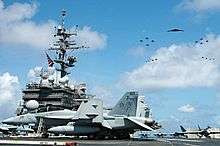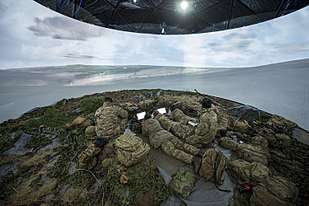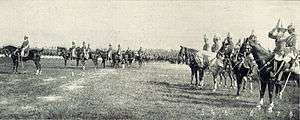Military exercise
A military exercise or war game is the employment of military resources in training for military operations, either exploring the effects of warfare or testing strategies without actual combat. This also serves the purpose of ensuring the combat readiness of garrisoned or deployable forces prior to deployment from a home base.
| Part of a series on |
| War |
|---|
|
|
|
Related
|

War games involving two or more countries allows for better coordination between militaries, observation of enemy's tactics, and is a visible show of strength for the participating countries.[1]
Exercises in the 20th and 21st centuries have often been identified by a unique codename, such as Cobra Gold, in the same manner as military contingency operations and combat operations like Operation Phantom Fury.
Types

Command Post Exercise
- A Command Post Exercise (CPX) typically focuses on the battle readiness of staffs such as a particular Unified Combatant Command or one of its components at any level. It may run in parallel with an FTX or its equivalent, or as a stand-alone event for headquarters staff only with heavy emphasis on simulated events.
Field exercise
- Historical names for the field exercise, or the full-scale rehearsal of military maneuvers as practice for warfare in the military services of the British Commonwealth include "schemes," while those of the military services United States are known as Field Training Exercises (FTX), or, in the case of naval forces, Fleet Exercises (FLEETEX).
- In a field exercise or fleet exercise, the two sides in the simulated battle are typically called "red" (simulating the enemy forces) and "blue", to avoid naming a particular adversary.[2] This naming convention originates with the inventors of the table-top war-game (the "Kriegsspiel"), the Prussian Georg von Reisswitz; their army wore Prussian blue, so friendly forces were depicted by the color blue.
Joint exercise
- Several different armed forces of the same nation training together are described as having a joint exercise, while those involving forces of multiple nations are described as having a combined exercise.
- These latter events incorporating multiple nations have often been referred to as NATO exercises, Coalition exercises, Bilateral exercises (based on security arrangements/agreements solely between two nations), Multilateral exercises (based on security arrangements/agreements between multiple nations), or other similarly named events.
Simulation
- Other types of exercise include the TEWT (Tactical Exercise Without Troops), also known as a sand table, map or cloth model exercise. This type of exercise (in recent years assisted by computer simulation) allows commanders to manipulate models through possible scenarios in military planning. This is also called warfare simulation, or in some instances a virtual battlefield and in the past has been described as "wargames." Such examples of modern military wargames include DARWARS, a serious game developed since 2003 by the US DARPA agency with BBN Technologies, a defense contractor which was involved in the development of packet switching, used for ARPANET, and which developed the first computer modem in 1963.
- Military's operations and training have included different scenarios a soldier might encounter with morals and different ethnics. In one military operation soldiers are frequently asked to engage in combat, humanitarian, and stabilization roles. These increase the ambiguity of a role one may encounter and challenge of ethics. This will also lead the military personnel to have to make a difficult call in challenging circu[3]mstances. Even in difficult situations and conditions, military personnel still has to follow rules and regulations such as: 1) when the right thing to do is not immediately clear; 2) when two or more important principles or values support different actions, and 3) when some harm will result, regardless of the actions taken (Defense Ethics Program, Department of National Defense, 2012). These simulations involve crude living conditions, sleep deprivations, time limit, and either lack or ambiguous amount of information.
- A subset of simulated exercises is the Table Top Exercise (TTX), typically limited to senior personnel stepping through the decision-making processes they would employ in a crisis, a contingency, or general warfare.
_-_photo_by_Nancy_Wong.jpg)
History
_and_HMS_Illustrious_(R_06)_in_the_Persian_Gulf_on_April_9%2C_1998.jpg)


The modern use of military exercises grew out of the military need to study warfare and to 'reenact' old battles for learning purposes. During the age of Kabinettskriege (Cabinet wars), Frederick the Great, King of Prussia from 1740 to 1786, "put together his armies as a well-oiled clockwork mechanism whose components were robot-like warriors. No individual initiative was allowed to Frederick's soldiers; their only role was to cooperate in the creation of walls of projectiles through synchronized firepower." [4]
This was in the pursuit of a more effective army, and such practices made it easier to look at war from a top-down perspective. Disciplined troops should respond predictably, allowing study to be confined to maneuvers and command.
The stunning Prussian victory over the Second French Empire in the Franco-Prussian War (1870–71) is sometimes partly credited to the training of Prussian officers with the game Kriegspiel, which was invented around 1811 and gained popularity with many officers in the Prussian army. These first wargames were played with dice which represented "friction", or the intrusion of less than ideal circumstances during a real war (including morale, meteorology, the fog of war, etc.).
21st century militaries still use wargames to simulate future wars and model their reaction. According to Manuel de Landa, after World War II the Command, Control and Communications (C3) was transferred from the military staff to the RAND Corporation, the first think tank.
Von Neumann was employed by the RAND Corporation, and his game theory was used in wargames to model nuclear dissuasion during the Cold War. Thus, the US nuclear strategy was defined using wargames, "SAM" representing the US and "IVAN" the Soviet Union.
Early game theory included only zero-sum games, which means that when one player won, the other automatically lost. The Prisoner's dilemma, which models the situation of two prisoners in which each one is given the choice to betray or not the other, gave three alternatives to the game:
- Neither prisoners betrays the other, and both are given short-term sentences
- One prisoner betrays the other, and is freed, while the other gets a long sentence
- Both prisoners betray each other, and both are given mid-sized sentences
This modelization gave the basis for the massive retaliation nuclear doctrine. The zero-sum fallacy and cooperative games would be theorized only later, while the evolution of nuclear technology and missiles made the massive retaliation nuclear strategy obsolete.[5]
See also
References
- "Why Russia and China's joint military exercises should worry the West". The Economist. Retrieved 2018-09-13.
- "Archived copy". Archived from the original on 2015-11-17. Retrieved 2015-11-15.CS1 maint: archived copy as title (link)
- Thompson, Megan M.; Jetly, Rakesh (2014-08-01). "Battlefield ethics training: integrating ethical scenarios in high-intensity military field exercises". European Journal of Psychotraumatology. 5 (s2): 23668. doi:10.3402/ejpt.v5.23668. ISSN 2000-8198. PMC 4138704. PMID 25206947.
- Manuel de Landa, War in the Age of Intelligent Machines, p.127, Swerve Editions, New York, 1991
- Concerning the use of military wargames, see Manuel de Landa, War in the Age of Intelligent Machines
External links
- Complete 911 Timeline: Center for Cooperative Research—Military exercises up to 9/11